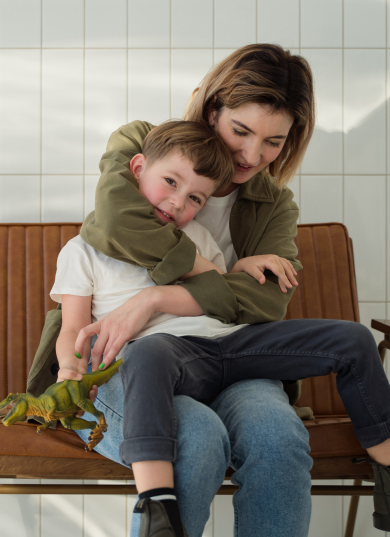High chairs, bouncers, floor seats, baby swings, jumpers and baby walkers all allow your infant to watch the world go by, safe in their little seat.
At home, ‘containers’ like these give you some hands-free time, and at child care, a high chair affords your baby a bird’s eye view of activities and allows easy service of solid food.
When it comes to container time, less is more, though.
Being constantly transferred from container to container, with little room for free movement, can cause something called ‘container baby syndrome.’
Today, we see what this means for littlies, and investigate ways that educators prevent this syndrome in the child care environment.
What is container baby syndrome?
This term describes the collective issues when a baby spends too much time in devices that limit their movement and stop them exploring their environment.
The American Physical Therapy Association of health professionals says that excessive time in containers puts bubs at increased risk of issues like:
- Plagiocephaly (flat spots on the head or flat head)
- Decreased muscle strength (e.g. in the legs and core), and
- Developmental delays lke delayed motor milestones.
Being stuck in a container for long periods of time can result in babies taking longer to learn key skills for the child's development, like rolling, sitting, standing and walking, because they don’t get as many opportunities to practice their motor skills movements and use their muscles as nature intended.
A baby might also suffer from torticollis, where tight neck muscles give them a neck tilt. Plus, some experts say too much time in a container can impact the spine and hip development, your baby's head shape and even cause social and cognitive delays.
How can container baby syndrome be prevented at child care?
Educators are alert for signs of container baby syndrome, and they’ll speak to the centre director and yourself if they notice any of the above issues in your baby.
If your infant does have container baby syndrome, you can work together to reverse the effects, but because prevention is better than a cure, educators do two key things to avert the problem:
1. Educators avoid containers as much as possible
Although it’s normal for parents to transport babies to care in a car seat or stroller, once the child care day starts, your infant is encouraged to not to stay in one position but instead move freely and naturally (in line with their age and developmental stage).
Play pens provide room to wriggle, kick and stretch, in different positions and caregivers will carry your baby around in their arms and give them lots of cuddles to support their physical, emotional and social development.
When a container is necessary (e.g. your older baby needs to sit in a high chair to slurp their solids), educators try to limit this container time to about 15 or 20 minutes.
Afterwards, it’s best for your baby to be let loose (in a safe, supervised way), instead of being moved to another supportive device.
2. Educators ensure babies get plenty of floor time
Floor time in a baby-friendly play space is essential for your children's independent movement, muscle building and sensory development, and this happens on their back and on their tummy.
Lying back on a foam mat or soft rug gives your bub opportunities to reach, roll, touch, look and listen; and hanging mobiles and overhead activity gyms encourage them to move their arms, legs and head.
Educators may also encourage your baby to follow sound and movement with their bodies, by softly clicking, clapping or singing around them.
On the flip side, tummy time is an essential part of floor time and may stave off container baby syndrome.
Tummy time involves your bub being placed on their tummy, with weight on their forearms, and it’s done in short bursts to build their head control, neck and upper body strength.
Raising Children offers parent education and suggests one to two minutes of tummy time, two or three times a day, when your bub is a few weeks old, building up to 10 to 15 minute stretches, several times a day, as they grow and strengthen.
It’s important that educators supervise tummy time, and they can use things like toys, books and baby-safe mirrors to encourage your baby to:
- Move, lift and turn their head
- Build eye and muscle strength, and
- Stay interested.
Some babies aren’t big fans of tummy time, but educators have lots of tricks to make it more pleasant or entertaining for them, such as lying down face-to-face with your baby's face and giving them a big smile and hand-stroke.
When it’s time for sleep, a cot is one container that’s roomier and essential for your bub’s health and well-being.
From birth, your baby should be put to sleep on their back to reduce their risk of sudden and unexpected death in infancy, and your child care centre has dedicated facilities and practices to ensure they rest easy, before hitting the floor and arms again!
How much container time should your baby get at home?
At home, it’s equally important to give your baby plenty of time out of their supportive devices, which means car seats, strollers and prams should be used for transport, not continuous baby containment.
Devices like bouncers, high chairs and floor seats have their benefits, and there’s no need to remove them from your life altogether, but it’s important to give your children much more floor time than container time.
As a guide, one paediatric physical therapist suggests that 15 to 20 minutes of container time, two times a day, is the right amount for babies (not counting the time they spend being transported).
When it comes to transport, the paediatric physiotherapist recommends that you use a baby carrier more often than a container, like a pram, because it’s less restrictive.
All in all, your baby needs freedom of movement in safe surroundings, and both you and your educator can take steps to prevent container baby syndrome and build your baby’s capabilities and curiosity as well as encourage the development of new skills. Hello world!
Further reading
































